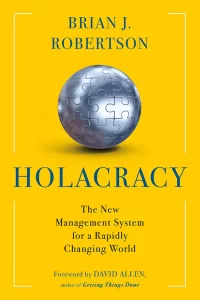Summary
Article 3 defines a “Tactical meeting” process for regular operational meetings in each team. It is designed to be highly efficient by relying on the role structure defined with the Organizational Structure module.
The tactical meeting process is suited to most teams, but some may already have a specific meeting process (e.g. Scrum meeting for software developers). For that reason, this module has a provision for amending the tactical meeting process or replacing it entirely.
Business value
- Highly efficient at allowing team members to surface and sharing information, bring up issues they need help with, while not getting lost in long tangential conversations or letting anyone dominate the space to the detriment of the team.
- Using a good Holacracy Support Software will help facilitate the Tactical Meeting process and integrate with your role structure.
Key Features
Below is a summary of key elements from this module. For the actual rules, please see Constitution – Article 3.
Surface Data
Defines a preamble to the meeting focused on surfacing data to get a snapshot of current reality. This phase is not about having conversations, it’s instead to identify issues to discuss in the next steps of the meeting. The preamble includes a space for checklists review, metrics review, and updates on projects.
Why it’s useful:
- Creates a space for roles solely to report key data, uninterrupted by discussions about that data.
- Prevents tangential conversations and rambling
Open Agenda
Provides a space for all meeting participants to add items to the meeting agenda. This ensures everyone has an opportunity to get their issues addressed.
Why it’s useful:
- Allows everyone to have an opportunity to address their issues.
- Doesn’t require anyone to spend time preparing a meeting agenda for everyone in advance.
- Agenda is built based on current needs from participants.
Efficient Triage
Sets clear guardrails for how the agenda is processed, one item at a time, to ensure an efficient use of time. For each agenda item, the discussion is focused solely on the needs of the person who added it. In that sense, the agenda is not a list of topics for everyone to discuss, but rather a list of specific needs for someone to resolve. Everybody can participate to the discussion to the extent it serves the need of the person who raised the agenda item. This method ensures a clear end point for each item by asking the item holder: “did you get what you need?”
Why it’s useful:
- Everyone has an opportunity for the team to help with their specific need.
- Prevents never-ending discussions, rambling, tangents, and the awkwardness of spending 30 min on a topic because everyone just wants to “add their 2 cents”.
- Cuts through the need to build consensus, thanks to clear decision-making authority defined with the Organizational Structure module.
- Meetings finish on time, or early 🙂
Alternatives to Holacracy’s Tactical Meetings
Holacracy’s Tactical Meeting is a good generic meeting full of best practices, but it is not critical to adopt this module. If you already have efficient meetings and everybody is satisfied with them, it is safe to skip this module if you choose to. At the same time, because this module is so flexible (the Tactical meeting process can easily be modified), it is safe to adopt it even if you don’t intend to use it as is.
If you decide not to adopt the Tactical Meetings module, it is highly recommended that you adapt your existing meeting process to the role structure defined through Module 1: Organizational Structure. In the early stages of your Holacracy adoption, failing to do so may result in undermining your role structure entirely as people will naturally refer to the legacy power structure.
For aligning with your role structure, we recommend using a Holacracy Support Software, which typically offers a meeting interface integrated with your role structure.
